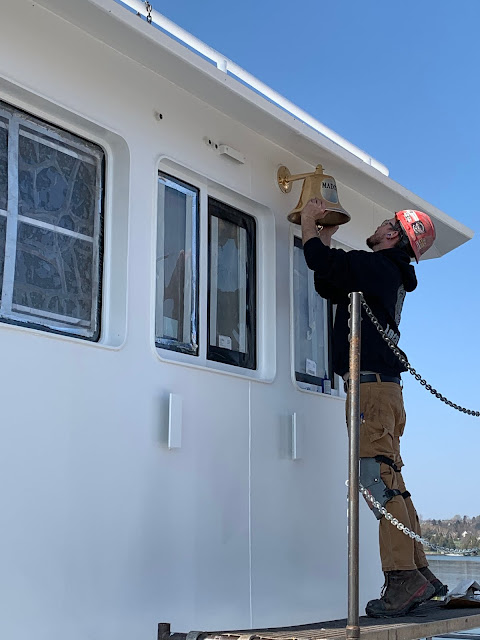Detroit Harbor, Washington Island
We're in the ninth month of construction, and details that will enable this ferry vessel to be ready for sea trials, for the U. S. Coast Guard Certificate of Inspection, and acceptance by Washington Island Ferry Line, continue to be addressed by the Fincantieri Bay Shipbuilding work force.
One item was accomplished early Saturday morning, at a time when few workers would be in the yard. On board Madonna, naval architect Mark Pudlo and several workers affirmed the placement of known weights on the main deck, set a prescribed distance from vessel centerline. The degree of heel was then noted by plum bob, and also the waterline changes on the hull's exterior. Then the same known weights (a total of over 28,000 pounds) were moved further outboard a prescribed distance from centerline, and additional readings were taken.
Calculations using those figures give the naval architect the vessel's heeling moment, which will denote either the "tenderness" or the "stiffness." the vessel's tendency to remain sufficiently stable under load and resist heeling, and the inherent tendency to return to a level, static condition. (This, in layman's terms!).
 |
| Known weights like the one above were placed in a line, at exact distances from vessel centerline, to give heeling measurement. |

Each of our other ferries have had excellent stability, by design and then through experience, which in turn enable us to carry two fully-loaded semis at 90,000 lbs. each. This will also be reflected in the vessel's Certificate of Inspection which limits the deck loads and their arrangement on board. (Today's stability rules hearken back to the Eastland disaster in 1915 in the Chicago River, where insufficient stability caused the vessel to roll over when numbers of passengers moved in concert to one side to view a passing vessel.)
The Arni J. Richter has, we think, a preponderance to roll a bit more in a sea, due to rounded bilge vs. a very hard chine, unlike our other ferries, and yet this ferry has proven to be a very stable vessel overall, and verified in actual practice through transporting heavy deck loads.
 |
| Plum bob with strip of masking tape measures number of inches of movement, upon shifting known weight outboard a known distance from centerline. |
 |
| Wiring the AC panel. |
Certain fire safety standards have to be met. One is to have a method to control a fire in the engine room space, the place onboard a vessel where there are statistically more opportunities for fires to break out.
A fire suppression system using CO2 was the method selected, and here a row of 100# bottles are arranged in a manner so as to be piped into the engine room and dispersed in a uniform manner.(An alarm will sound before release, to alert any persons within that space to get topside).
This installation is made through a subcontracted specialist, with yard personnel assisting in fitting and welding. The system will be tested in accordance with Coast Guard standards, and regular testing will be conducted throughout the life of the vessel.

 |
| Carpenters insulate and panel the passenger cabin (above) and pilot house. |
One photo here shows the piping to the fuel tank, where water will be slowly fed by garden hose and levels are accurately measured in the tank with a calibrated stick. (This, after stability measurements have been made.) Then the water will be removed, the fuel tank wiped clean, and a fill of fresh diesel (at approx. 95 cents/gal. under current pricing) will be added.
These are some of the continuing activities on the new Washington Island Ferry Madonna, at the Bay Shipbuilding facility. - Dick Purinton





1 comment:
As I have said before, I think a winter building a new ferryboat would be about perfect. I suppose you ran into a few problems on the way, but the launching will forget all the work. She is beautiful. Kilpela
Post a Comment